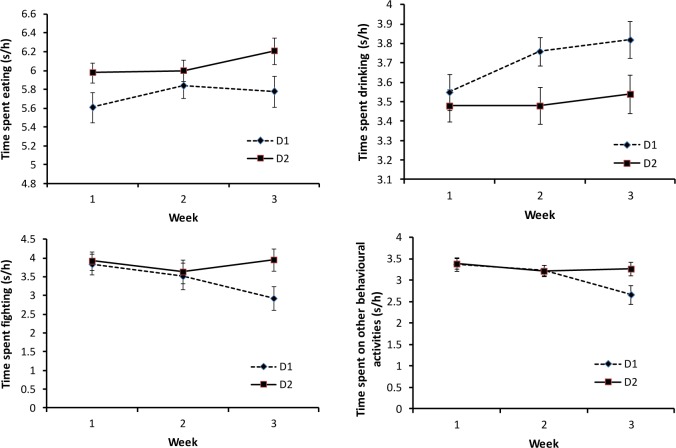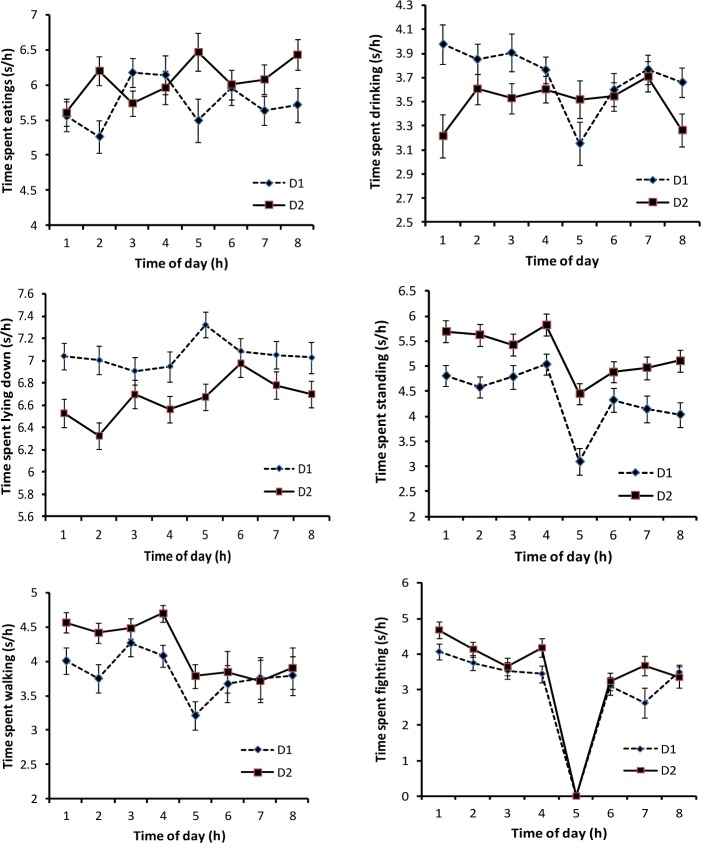Abstract
The objective of the study was to investigate the effect of feeding fibrous diets on growth performance and occurrence of aggressive behaviours in growing pigs. Sixty healthy castrated pigs (initial body weight: 46.7±4.35 kg) were used. A basal diet was diluted with maize cobs to two levels (0 and 160 g/kg dry matter). Behavioural activities were observed using video cameras for three weeks, 8 h/d starting at 0800 h. Pigs subjected to control diet gained more weight compared to pigs receiving fibrous diet in week 1 (0.47 vs 0.15 kg, respectively) and 2 (1.37 vs 1.04, respectively) (p<0.05). Average daily gain was not affected by treatment diet in the third week. Pigs on high fibrous spent more time eating, lying down, standing, walking and fighting (p<0.05) compared to pigs on control diet. Time spent eating increased as the weeks progressed whilst time spent lying down decreased. Time of day had an effect on time spent on different behavioural activities exhibited by all pigs on different treatment diet (p<0.05). Inactivity was greatest in 5th (1200 to 1300 h) hour of the day for all the pigs on different dietary treatments. Skin lesions appeared the most on neck and shoulder region followed by chest, stomach and hind leg region, and finally head region (p<0.05). Pigs on high fibre diet had more skin lesions in all body regions compared to pigs on control diet (p<0.05). It can be concluded that the high fibrous diet with maize cobs did not affect growth performance and also did not reduce aggressive behaviours. Aggressive behaviours emanated out of frustration when queuing on the feeder. The findings of this study suggest that maize cobs can be included at a level of 160 g/kg in diets of pigs. However, to reduce the level of aggression more feeding space should be provided.
Keywords: Aggressive Behaviour, Fibrous Diet, Pigs, Skin Lesions
INTRODUCTION
Rearing of pigs in groups is more prominent under commercial farming practices. This offers benefits which include the use of labour-saving machinery and bedding systems, and practicing of all-in-all-out production which facilitates health management (Turner et al., 2003). When pigs are in groups, they exhibit aggressive behaviours more often to establish ranks and also to compete for limited resources (feed and water). These behaviours cause injuries to pigs which lead to mortalities and also reduction in weight gain. Fibrous feedstuffs are expected to reduce aggressive behaviours. The fibrous feedstuff increase the volume of feed eaten and/or time spent eating (Day et al., 1996; Weber et al., 2008), which is mainly attributed to the reduced density of nutrients. The pigs have to eat more of the less nutrient dense feed for them to meet requirements for growth. The fibres cause gut fill and also provide a substrate for chewing and rooting activities, thus, reducing the risk of the development and/or time spent on aggressive behaviours. Aggressive encounters frequently result in skin injuries; hence, apart from determining time spent on the behavioural activity, level of skin damage could also be used to reflect differences in observed levels of aggression of pigs fed fibrous diets.
Maize cobs were used as a fibre source in the experiment. It has a low water holding capacity which does not depress feed intake greatly at 160 g/kg. The inclusion level of maize cobs at 160 g/kg in a diet corresponds to 138 g/kg optimum level of acid detergent fibre (ADF), which does not constrain gut capacity in pigs (Ndou et al., 2013). The objective of the study was, therefore, to determine the effect of feeding the fibrous diet on growth performance and aggressive behaviours of grouped growing pigs. It was hypothesized that the fibrous diet does not affect growth performance and it also reduces aggressive interactions.
MATERIALS AND METHODS
Pigs and housing
Care and use of the pigs were in compliance with internationally accepted standards for welfare and ethics in animals and was specifically approved by the University of KwaZulu-Natal Animal Ethics Research Committee (Reference number: 061/12/Animal). Sixty healthy castrated growing pigs (Initial body weight: 46.7±4.35 kg) were used in the study. The pigs were randomly assigned to six groups, 10 in each pen. Stocking density of pigs in each pen was 0.627 pigs/m2. The pens had concrete floors and brick walls. Feed was provided ad libitum from one tube feeder permanently fixed at the centre of each pen. Water was also provided ad libitum from low pressure nipple drinker located on the wall of the pen.
Diets and feeding
A commercial feed (Grower, Meadow Feeds Ltd., Pietermaritzburg, South Africa) with a low level of fibre was used as control diet (basal diet). The basal diet had the following ingredients; yellow maize (500 g/kg), soya bean (158 g/kg), soybean oil cake (20.2 g/kg), wheat bran (163 g/kg), sunflower oil cake (85 g/kg), molasses syrup (25 g/kg) and additives (48.8 g/kg). Maize cobs were used as the fibre source. They have a considerable amount of neutral and ADF (Ndou, 2012). The cobs were ground to pass through a 3 mm screen and thereafter were included in a basal diet at a level of 160 g/kg. Three of the groups were subjected to a fibrous diet containing maize cob meal. The remaining three groups received a control diet (basal diet).
Analyses of physicochemical properties of diets
Ash, dry matter, crude protein, and crude fibre were determined according to the method of AOAC (2005). Neutral detergent fibre and ADF were analysed using filter bags by means of a fibre analyzer (Ankom 220, Ankom Technology Corp. Macedon, NY, USA). A bomb calorimeter was used to determine gross energy of feed. Bulk density of the feeds was measured according to the water displacement method described by Peterson and Baumgardt (1971). Water holding capacity was determined by centrifugation (Robertson and Eastwood, 1981). Chemical and physical properties of control and fibrous diet are described in Table 1.
Table 1.
Chemical and physical properties of control and fibrous diet
| Treatment diets
|
||
|---|---|---|
| Control | Fibrous diet | |
| DM (g/kg) | 90.14 | 90.91 |
| Calc DE1 (g/kg DM) | 10.75 | 10.56 |
| CP (g/kg DM) | 247.8 | 207.9 |
| EE (g/kg DM) | 3.73 | 5.45 |
| Ash (g/kg DM) | 5.52 | 5.04 |
| NDF (g/kg DM) | 430.93 | 470.3 |
| ADF (g/kg DM) | 68.39 | 185.59 |
| BD (g DM/mL) | 1.83 | 1.65 |
| WHC (g water/g DM) | 4.6 | 5.71 |
DM, dry matter; CP, crude protein; EE, ether extract; Calc DE, calculated digestible energy; NDF, neutral detergent fibre; ADF, acid detergent fibre; BD, bulk density; WHC, water holding capacity.
Calc DE = 949 + (0.789×GE)–(43×% Ash) − (41×% NDF) (Noblet and Perez, 1993).
Observations
Pigs were allowed to adapt to their new environment, the feed offered and to using the feeders for two weeks. The period would also allow them to establish ranks so that the effect of diet on aggressive behaviour could be clearly defined. Each pig was weighed at the beginning of the experiment and, thereafter, weekly.
Injuries emanating from aggression behaviours were assessed on individual pigs in each group. This was done at the beginning of the experiment and, thereafter, weekly on fresh lesions when the pigs were being weighed. To facilitate counting, the body was divided into three regions: head, neck and shoulder region, and the remaining parts of the body. Recordings were done only on fresh lesions, which were judged subjectively by colour and the estimated age of scabbing (Turner et al., 2006).The scoring method used followed that of Stukenborg et al. (2012). To keep the scores consistent throughout the experiment, one person assessed the injury scores.
Behavioural activities of pigs in each pen were recorded continuously using video cameras mounted on the ceiling for eight hours, starting at 0800 h and ending at 1600 h. All pigs were numbered on the back with paint, which aided in the accurate identification during observation. Behavioural activities observed in the study are shown in Table 2. Time spent on different behavioural activities was observed for a period of three weeks, once a week. The behavioural activities were scored by the same person during the study period. For determining number of fights made by pigs in each group, a fight was recorded when it took longer than 2 s and a new fight started if there was an intervening period of more than 8s (Puppe, 1998).
Table 2.
Description of behavioural activities
| Behavioural activity | Description |
|---|---|
| Feeding behaviour | |
| Eating | Consumption of feed material from the feeder |
| Drinking | Manipulating the water bowl |
| Postures | |
| Standing | Standing without eating or manipulating the water bowl |
| Lying down | Sprawl down to rest |
| Walking | Moving from one position to another |
| Abnormal behaviours | |
| Fighting | Repeated biting and pushing |
| Other | Object-biting, nose-rubbing, mounting |
Statistical analyses
For the analysis of the behavioural data, proc capability procedures of SAS (SAS, 2008) were used to check for normality of data for time spent on different behavioural activities exhibited by pigs. Logarithmic transformation was used to normalise the data for time spent on different behavioural activities since it was not normally distributed. Data for behavioural activities, skin lesion scores and number of fights were analysed using the mixed model procedures for repeated measures (SAS, 2003). The Dunnett t-test was used to compare means for treatment with the control at p<0.05. For the comparison of behaviour of grouped pigs subjected to the treatment diets, the pen was considered as the experimental unit and the model included the effects of treatment diet, week, time of day and possible interactions as independent variables.
RESULTS
Average daily gain for all the pigs subjected to the treatment diets increased during the three week period as illustrated in Figure 1. Pigs subjected to control diet gained more weight compared to pigs receiving fibrous diet in week 1 and 2 (p<0.05). In week 3, there were no differences in weight gain for all the pigs subjected to the different dietary treatments (p<0.05).
Figure 1.
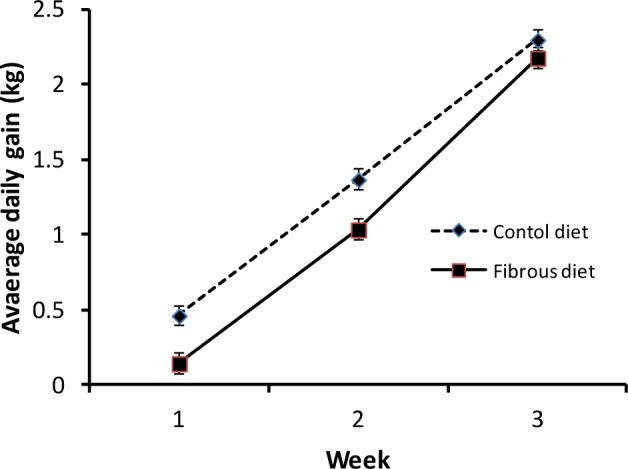
Average daily gain for pigs on different treatment diets.
Diet influenced time spent on different behavioural activities (p<0.05; Table 3). Pigs subjected to fibrous diet spent more time eating, lying down, standing, walking and fighting. However, no differences were observed for time spent on other behavioural activities.
Table 3.
Effect of feeding different diets on time spent (s/h) (mean±standard error on different behavioural activities)
| Treatment diets
|
||
|---|---|---|
| Control diet | Fibrous diet | |
| Feeding behaviour | ||
| Eating | 5.7±0.08a | 6.1±0.07b |
| Drinking | 3.7±0.05b | 3.5±0.05a |
| Postures | ||
| Lying down | 7.1±0.04a | 6.7±0.04b |
| Standing | 4.4±0.07a | 5.3±0.06b |
| Walking | 3.8±0.05a | 4.2±0.05b |
| Abnormal behaviours | ||
| Fighting | 3.4±0.12a | 3.8±0.10b |
| Other | 3.1±0.10a | 3.3±0.08a |
Interaction of week and treatment on time spent on different behavioural activities was also significant (p<0.05). Generally, time spent eating and drinking increased as the pigs grew (as body weight increased) on the different dietary treatments (Figure 2). Pigs receiving fibrous diet spent more time eating compared to pigs subjected to control diet. Conversely, pigs receiving control diet spent more time drinking compared to pigs subjected to fibrous diet. A similar trend was observed for interaction of week and time spent lying down, fighting and other behavioural activities for all pigs (Figures 2 and 3). Time spent eating increased in the first two weeks for all the pigs. However, in the third week time spent eating by pigs receiving fibrous diet increased compared to pigs on a control diet. Time spent drinking increased for the pigs receiving different dietary treatments as the weeks progressed. Time spent standing and walking in week 1 and week 2 increased then later decreased in the third week for pigs subjected to control diet.
Figure 2.
Effect of week and treatment on time spent on feeding and abnormal behaviours of pigs. D1, control diet; D2, fibrous diet.
Figure 3.
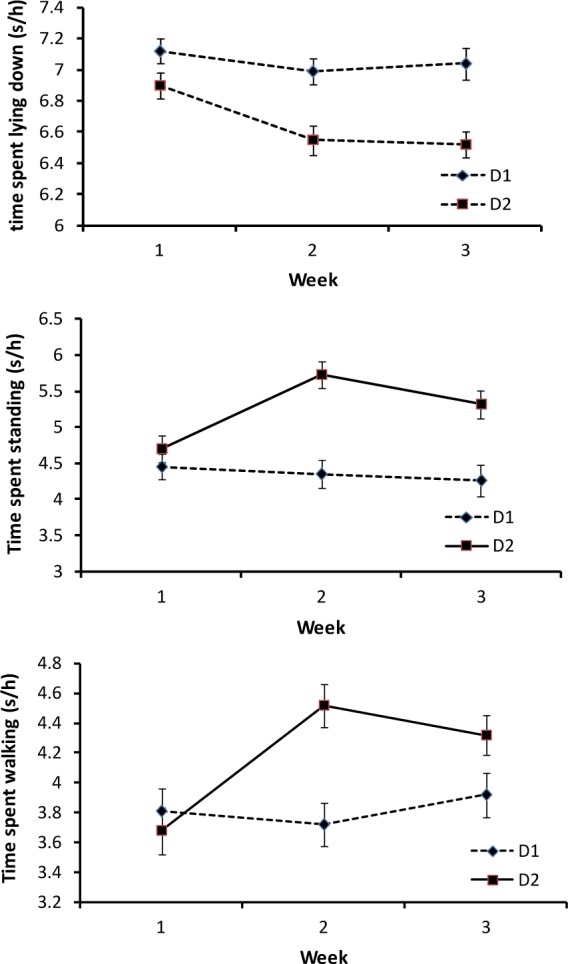
Effect of week and treatment on time spent on different postures exhibited by pigs. D1, control diet; D2, fibrous diet.
Figure 4 shows the effect of time of day and inclusion level of maize cobs on time spent on different behavioural activities. There was a similar pattern for time spent lying down, standing, walking and fighting regardless of diet offered to the pigs. Peaks for time spent lying down for pigs receiving control and fibrous diet were in the 5th (1200 to 1300 h) and 6th (1300 to 1400 h) hour of the day, respectively. A sharp decrease in time spent standing, walking and fighting was observed in the 5th (1200 to 1300 h) hour of the day for all the pigs. In general, aggressive behaviours decreased as the day progressed.
Figure 4.
Effect of time of day and treatment on time spent on different behavioural activities. D1, control diet; D2, fibrous diet.
Greatest number of lesions occurred on neck and shoulder region followed by chest, stomach and hind leg region, and finally head region (p<0.05; Figure 5). Pigs subjected to fibrous diet had more lesions compared to pigs receiving control diet (p<0.05). Week had no effect on the number of lesions on pigs receiving the two diets. Figure 6 shows the mean number fights for pigs subjected to the two diets. Higher incidence of fighting was observed in pigs subjected to fibrous compared to control diet (p<0.05).
Figure 5.
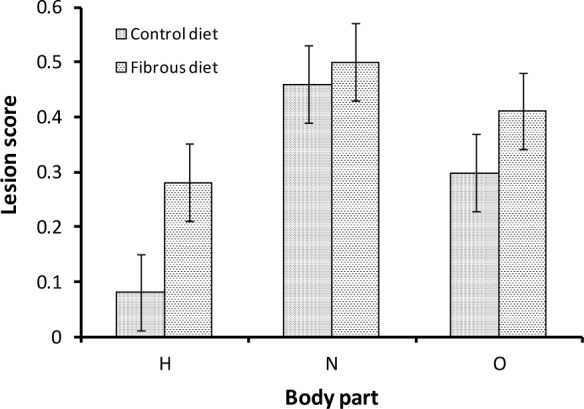
Mean skin lesion scores for pigs on different treatment diets. H, head region; N, neck and shoulder region; O, rest of the body.
Figure 6.
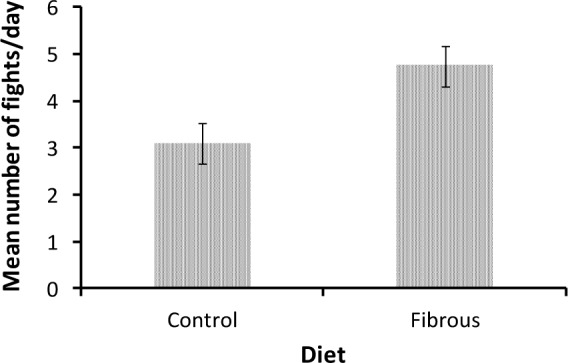
Mean number of fights for pigs on different diets.
DISCUSSION
The observation that pigs had an improved weight gain in week 3 compared to the previous weeks might be an indication that the pigs are beginning to tolerate the fibrous diet provided. This is in agreement with study conducted by Kallabis and Kaufmann (2012).
The study has shown level of skin damage on pigs to reflect levels of aggression in pigs subjected to the treatment diets. This is evident from the observations made were pigs on fibrous diet spent more time fighting compared to pigs on control diet. Simultaneously, more lesions were found on pigs receiving fibrous diet compared to pigs on control diet.
The observation that lesion scores are greater in diets with fibrous diet compared to control diet was not expected. Inclusion of fibrous diet was expected to reduce incidence of fighting since most of the pigs will be devoting most their time eating. The high feeding motivation frequently resulted in aggression, particularly around feeding stations. The observation that more lesions occur on the neck and shoulder region was expected. This is mainly because when pigs are fighting they position themselves so that their heads align on each other’s shoulders. Slamming of their heads into each other’s shoulders will result in more cuts or lesions on the neck and shoulder regions. Fighting will persist until one pig admits defeat and runs away. Lesions on the head during the study period occurred when pigs were displacing each other from the feeder and nipple drinkers.
The observation that more time was spent eating by pigs on a fibrous diet compared to control diet is in agreement with a previous studies (Whittaker et al., 1999; Whittemore et al., 2002; Rijnen et al., 2003). More time spent eating is a result of unsatisfied feeding motivation, as a consequence of dilution effect of maize cobs to the basal diet. The pigs will be eating more to get nutrients to satisfy their nutritional requirements for growth.
As observed in the current study, more time spent eating by a pig receiving a fibrous diet at the feeder resulted in more time spent queuing by another pig at the feeder. This might account for more time spent standing by pig receiving fibrous diets as observed in the current study. More time spent walking emanated when pigs were walking around sniffing the floor. Such findings are in agreement with previous studies which refer the action as substrate-directed behaviour (de Leeuw et al., 2005). Substrate-directed behaviour occurs when there is an increase in feeding motivation and limited access to the feed. Increase in time spent lying down came entirely from a decrease in time spent eating.
Previous studies have shown time spent eating to be positively correlated to time spent drinking (Barber et al., 1989; Dybkjær et al., 2006). Pigs receiving fibrous diets are expected to spend more time drinking compared to pigs subjected to low fibrous diets. This was not the case in the study as pigs on low fibrous diet spent more time drinking. Possible explanation to this might lie in the method used in the study for assessing drinking behaviour (Meiszberg et al., 2009). Drinking behaviour in the study was defined as mouth in contact with the nipple drinker and does not include the amount of water ingested. More time spent drinking by pig on control diet might have resulted from boredom and, therefore, will be playing with the nipple drinker.
With regard to diurnal behavioural patterns, a decrease in time spent on the activities like walking, standing, drinking and fighting in the 5th hour (1200 to 1300 h) might be attributed to the pigs spending more time lying down mainly because it was the hottest hour of the day. More time spent lying down could be explained as a sign of enhanced satiety for all the pigs subjected to the different treatment diets (Robert et al., 1993). Pigs showed an almost similar diurnal pattern for the behavioural activities regardless of treatment diet. There may be a physiological mechanism induced by photoperiod influencing behavioural patterns exhibited by all pigs subjected to the different treatment diets (Whittemore et al., 2002). In the morning when fresh feed is put in feeders, there will be a lot of activity among the pigs as they will be anticipating a share of the feed. They, therefore, queue at the feeder. Aggression emanates out of frustration has they will be waiting for a longer period for another pig to finish eating (Whittaker et al., 1999).
CONCLUSIONS
From the pigs used in the present study, it can be concluded that weight gain of pigs was not affected by the treatment diets. On the other hand, high fibrous diets did not reduce aggressive behaviours. Aggressive behaviours emanated out of frustration when queuing at the feeder. Aggressive behaviours might have been reduced if more feeders were made available to reduce completion for access of feed.
REFERENCES
- AOAC. Official Methods of Analysis. 18th ed. Association of Analytical Chemists; Washington, DC, USA: 2005. [Google Scholar]
- Barber J, Brooks PH, Carpenter JL. The effects of water delivery rate on the voluntary food intake, water use and performance of early-weaned pigs from 3 to 6 weeks of age. In: Forbes JM, Varley MA, Lawrence TLJ, editors. The Voluntary Feed Intake of Pigs. British Society of Animal Production; Edinburgh, UK: 1989. pp. 103–104. (Occ. Pub. No. 13). [Google Scholar]
- Day JE, Kyriazakis I, Lawrence AB. The use of a second-order schedule to assess the effect of food bulk on the feeding motivation of growing pigs. Anim Sci. 1996;63:447–455. [Google Scholar]
- De Leeuw JA, Zonderland JJ, Altena H, Spoolder HAM, Jongbloed AW, Verstegen MWA. Effects of levels and sources of dietary fermentable non-starch polysaccharides on blood glucose stability and behaviour of group-housed pregnant gilts. Appl Anim Behav Sci. 2005;94:15–29. [Google Scholar]
- Dybkjær L, Jacobsen AP, Tøgersen FA, Poulsen HD. Eating and drinking activity of newly weaned piglets: Effects of individual characteristics, social mixing, and addition of extra zinc to the feed. J Anim Sci. 2006;84:702–711. doi: 10.2527/2006.843702x. [DOI] [PubMed] [Google Scholar]
- Kallabis KE, Kaufmann O. Effect of a high-fibre diet on the feeding behaviour of fattening pigs. Arch Tierz. 2012;55:272–284. [Google Scholar]
- Meiszberg AM, Johnson AK, Sadler LJ, Carroll JA, Dailey JW, Krebs N. Drinking behavior in nursery pigs: Determining the accuracy between an automatic water meter versus human observers. J Anim Sci. 2009;87:4173–4180. doi: 10.2527/jas.2008-1737. [DOI] [PubMed] [Google Scholar]
- Ndou SP. MSc Thesis. University of KwaZulu-Natal; Pietermaritzburg, South Africa: 2012. Prediction of gut capacity of weaner and finishing pigs using physicochemical measurements of bulkiness of fibrous feeds. [Google Scholar]
- Ndou SP, Gous RM, Chimonyo M. Prediction of scaled feed intake in weaner pigs using physicochemical properties of fibrous diets. Br J Nutr. 2013;110:774–780. doi: 10.1017/S0007114512005624. [DOI] [PubMed] [Google Scholar]
- Noblet J, Perez JM. Prediction of digestibility of nutrients and energy values of pig diets from chemical analysis. J Anim Sci. 1993;71:3389–3398. doi: 10.2527/1993.71123389x. [DOI] [PubMed] [Google Scholar]
- Peterson DA, Baumgardt BR. Food and energy intake of rats fed diets varying in energy concentration and density. J Nutr. 1971;101:1057–1068. doi: 10.1093/jn/101.8.1057. [DOI] [PubMed] [Google Scholar]
- Puppe B. Effects of familiarity and relatedness on agonistic pair relationships in newly mixed domestic pigs. Appl Anim Behav Sci. 1998;58:233–239. [Google Scholar]
- Rijnen MMJA, Verstegen MWA, Heetkamp MJW, Haaksma J, Schrama JW. Effects of dietary fermentable carbohydrates on behavior and heat production in group-housed sows. J Anim Sci. 2003;81:182–190. doi: 10.2527/2003.811182x. [DOI] [PubMed] [Google Scholar]
- Robert S, Matte JJ, Farmer C, Girard CL, Martineau GP. High-fibre diets for sows: Effects on stereotypies and adjunctive drinking. Appl Anim Behav Sci. 1993;37:297–309. [Google Scholar]
- Robertson JA, Eastwood MA. A method to measure the water-holding properties of dietary fibre using suction pressure. Br J Nutr. 1981;46:247. doi: 10.1079/bjn19810030. [DOI] [PubMed] [Google Scholar]
- SAS. SAS User’s Guide: Statistics, Version 9.1. SAS Institute; Cary, NC, USA: 2008. [Google Scholar]
- Stukenborg A, Traulsen I, Stamer E, Puppe B, Krieter J. The use of a lesion score as an indicator for agonistic behaviour in pigs. Arch Tierz. 2012;55:163–170. [Google Scholar]
- Turner SP, Allcroft DJ, Edward SA. Housing pigs in large social groups: a review of implications for performance and other economic traits. Livest Prod Sci. 2003;82:39–51. [Google Scholar]
- Turner SP, Farnworth MJ, White IMS, Brotherstone S, Mendl M, Knap P, Penny P, Lawrence AB. The accumulation of skin lesions and their use as a predictor of individual aggressiveness in pigs. Appl Anim Behav Sci. 2006;96:245–259. [Google Scholar]
- Weber TE, Ziemer CJ, Kerr BJ. Effects of adding fibrous feedstuffs to the diet of young pigs on growth performance, intestinal cytokines, and circulating acute-phase proteins. J Anim Sci. 2008;86:871–881. doi: 10.2527/jas.2007-0330. [DOI] [PubMed] [Google Scholar]
- Whittaker X, Edwards SA, Spoolder HA, Lawrence AB, Corning S. Effects of straw bedding and high fibre diets on the behaviour of floor fed group-housed sows. Appl Anim Behavior Sci. 1999;63:25–39. [Google Scholar]
- Whittemore EC, Kyriazakis I, Tolkamp BJ, Emmans GC. The short-term feeding behaviour of growing pigs fed foods differing in bulk content. Physiol Behav. 2002;76:131–141. doi: 10.1016/s0031-9384(02)00686-8. [DOI] [PubMed] [Google Scholar]



